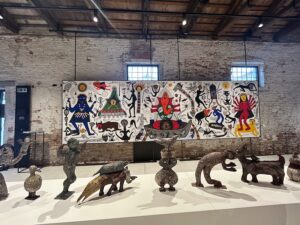Alex Ulam

Photo: Lee Sharrock
Although India is the birthplace of one of the world’s great civilizations and its contemporary culture has a formidable international influence, the country has never had a permanent national pavilion at the Venice Art Biennale. In fact, India has only officially participated twice with a national pavilion over the course of the Biennale’s 125 year history, in 2011 and in 2019. This year, however, in line with Biennale curator Adriano Pedrosa’s Foreigners Everywhere exhibition’s emphasis on the global south, Indigenous art and craft, India and its diaspora is making the strongest showing ever in Venice. There is work by a dozen Indian artists in the main show at the Arsenale, expat Indians are exhibiting at various national pavilions then there are several major shows.
One of the best places at this year’s Biennale to view what’s happening in contemporary Indian art today is at the Cosmic Garden exhibition staged by the Chanakaya Foundation at the Salone Verde in Venice’s Santa Croce neighborhood. On display is a wide variety of art in various mediums including sculpture, tapestry and oil painting by two of the most prominent artists working in India today, Madhvi Parekh and Manu Parekh who are wife and husband and have had a profound effect on one another’s careers.
It’s safe to say that this show includes some of the most elaborate crafted and detailed artworks in the entire Biennale. Case in point is Devi and Asura (2022) a brightly colored woven, stitched and sewn tapestry that represents a fiery conflict between two Hindu deities who embody the forces of good and evil and whose figures limbs akimbo dance around the tapestry in various incarnations. This multifaceted work is made from various materials including silk, linen and cotton, incorporates 32 different handicraft techniques and represents the work of 30 different craftspeople from the Chanakaya School of Craft who put in a cumulative 16,100 hours to fulfill Madhvi Parekh’s vison in a manner akin to subordinate artists in a Renaissance artist’s workshop.
The show exemplifies the current vogue for craft that has taken hold of the art world at large and can be seen in many examples of indigenous and western art on display throughout this year’s Biennale.However in India this is nothing new, because there never has been a real separation between the two. “This show blurs the boundaries between art and craft” said Raj Ghanta, vice-president of the Chanakaya Foundation, adding, “craft in India has never been institutionalized.”
What is new here is that the riot of colors and animated characters on display are updated versions of motifs in Indian art. Further, the various works in this exhibition are frequently in dialogue with one another. An acrylic painting by Madhvi Parekh called Village Opera portrays a soup of body parts, hybrid animal forms, and figures of ambiguous sex, that is in conversation with ten creatures, some ominous, some friendly, which are interspersed throughout the gallery and are sculpted from wire, limestone and paper mache.
While Madhvi’s Parekh’s paintings and sculptures are more grounded in traditional Hindu mythology and the traditional village where she grew up, her husband Manu’s work is less identifiable as Indian and indeed look as though he was heavily influenced by the international Surrealist movement. His Goddess (2014) constructed from found iron objects looks positively out of Duchamp’s dreamscape with a blue sphere staring at the viewer with a single eye while dangling underneath is an anthropomorphic orange creature dangling also staring out from a single eye.
Even when Parekh’s works are titled with a specific Hindu reference such as his work Shiva’s Tandav (2023), the acrylic on canvas painting is not readily identifiable as Indian. This abstract work is centered around three circular dark forms with different colored backgrounds that look as though they could be cellular forms emerged from underneath an microscope. Although wispy squiggly forms appear to be floating around the three dark cellular structures they do look as though they could be some deconstructed forms painted from a Hindu temple.
The Parekh’s already have an international following and included in the exhibit in Venice is one of the tapestries Third Eye (2023) that was produced by Manu Parekh, Karishma Swali and artisans from Chanakya School of Craft in collaboration with the Dior Foundation in Paris where it is part of a collection of work by the artists. This work made from organic, cotton, linen and raw silk thread on cotton textile features a cellular like creature consisting of mysterious series of circles highlighted by knotted threads with the mysterious eye that appears a recurring motif in Manu Parekh’s work. Surrounding the creature mashed together are a series of skeletal monstrous parts in indigo blue that look as though they are swirling around in one of Dante’s circles of hell.
Cosmic Gardens seems so perfect for Venice and this year’s Biennale. It hearkens back to the age when tapestries were more valuable than paintings, when art was on the same level as craft and when the connection between East and West brought new vigor and energy to artistic production. Indeed, the artist as a romantic individual with divine inspiration or some truth that we don’t all know doesn’t apply in this exhibition because it’s very much a joint enterprise.
